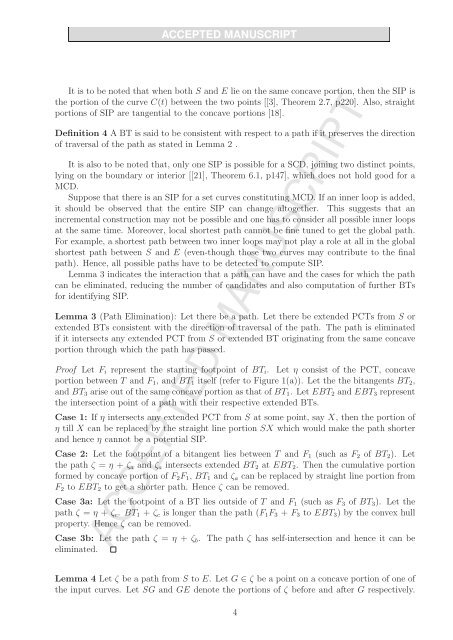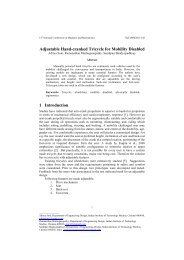Shortest path in a multiply-connected domain having curved ...
Shortest path in a multiply-connected domain having curved ...
Shortest path in a multiply-connected domain having curved ...
Create successful ePaper yourself
Turn your PDF publications into a flip-book with our unique Google optimized e-Paper software.
It is to be noted that when both S and E lie on the same concave portion, then the SIP is<br />
the portion of the curve C(t) between the two po<strong>in</strong>ts [[3], Theorem 2.7, p220]. Also, straight<br />
portions of SIP are tangential to the concave portions [18].<br />
Def<strong>in</strong>ition 4 A BT is said to be consistent with respect to a <strong>path</strong> if it preserves the direction<br />
of traversal of the <strong>path</strong> as stated <strong>in</strong> Lemma 2 .<br />
It is also to be noted that, only one SIP is possible for a SCD, jo<strong>in</strong><strong>in</strong>g two dist<strong>in</strong>ct po<strong>in</strong>ts,<br />
ly<strong>in</strong>g on the boundary or <strong>in</strong>terior [[21], Theorem 6.1, p147], which does not hold good for a<br />
MCD.<br />
Suppose that there is an SIP for a set curves constitut<strong>in</strong>g MCD. If an <strong>in</strong>ner loop is added,<br />
it should be observed that the entire SIP can change altogether. This suggests that an<br />
<strong>in</strong>cremental construction may not be possible and one has to consider all possible <strong>in</strong>ner loops<br />
at the same time. Moreover, local shortest <strong>path</strong> cannot be f<strong>in</strong>e tuned to get the global <strong>path</strong>.<br />
For example, a shortest <strong>path</strong> between two <strong>in</strong>ner loops may not play a role at all <strong>in</strong> the global<br />
shortest <strong>path</strong> between S and E (even-though those two curves may contribute to the f<strong>in</strong>al<br />
<strong>path</strong>). Hence, all possible <strong>path</strong>s have to be detected to compute SIP.<br />
Lemma 3 <strong>in</strong>dicates the <strong>in</strong>teraction that a <strong>path</strong> can have and the cases for which the <strong>path</strong><br />
can be elim<strong>in</strong>ated, reduc<strong>in</strong>g the number of candidates and also computation of further BTs<br />
for identify<strong>in</strong>g SIP.<br />
Lemma 3 (Path Elim<strong>in</strong>ation): Let there be a <strong>path</strong>. Let there be extended PCTs from S or<br />
extended BTs consistent with the direction of traversal of the <strong>path</strong>. The <strong>path</strong> is elim<strong>in</strong>ated<br />
if it <strong>in</strong>tersects any extended PCT from S or extended BT orig<strong>in</strong>at<strong>in</strong>g from the same concave<br />
portion through which the <strong>path</strong> has passed.<br />
Proof Let Fi represent the start<strong>in</strong>g footpo<strong>in</strong>t of BTi. Let η consist of the PCT, concave<br />
portion between T and F1, and BT1 itself (refer to Figure 1(a)). Let the the bitangents BT2,<br />
and BT3 arise out of the same concave portion as that of BT1. Let EBT2 and EBT3 represent<br />
the <strong>in</strong>tersection po<strong>in</strong>t of a <strong>path</strong> with their respective extended BTs.<br />
Case 1: If η <strong>in</strong>tersects any extended PCT from S at some po<strong>in</strong>t, say X, then the portion of<br />
η till X can be replaced by the straight l<strong>in</strong>e portion SX which would make the <strong>path</strong> shorter<br />
and hence η cannot be a potential SIP.<br />
Case 2: Let the footpo<strong>in</strong>t of a bitangent lies between T and F1 (such as F2 of BT2). Let<br />
the <strong>path</strong> ζ = η + ζa and ζa <strong>in</strong>tersects extended BT2 at EBT2. Then the cumulative portion<br />
formed by concave portion of F2F1, BT1 and ζa can be replaced by straight l<strong>in</strong>e portion from<br />
F2 to EBT2 to get a shorter <strong>path</strong>. Hence ζ can be removed.<br />
Case 3a: Let the footpo<strong>in</strong>t of a BT lies outside of T and F1 (such as F3 of BT3). Let the<br />
<strong>path</strong> ζ = η + ζc. BT1 + ζc is longer than the <strong>path</strong> (F1F3 + F3 to EBT3) by the convex hull<br />
property. Hence ζ can be removed.<br />
Case 3b: Let the <strong>path</strong> ζ = η + ζb. The <strong>path</strong> ζ has self-<strong>in</strong>tersection and hence it can be<br />
elim<strong>in</strong>ated.<br />
Lemma 4 Let ζ be a <strong>path</strong> from S to E. Let G ∈ ζ be a po<strong>in</strong>t on a concave portion of one of<br />
the <strong>in</strong>put curves. Let SG and GE denote the portions of ζ before and after G respectively.<br />
4




